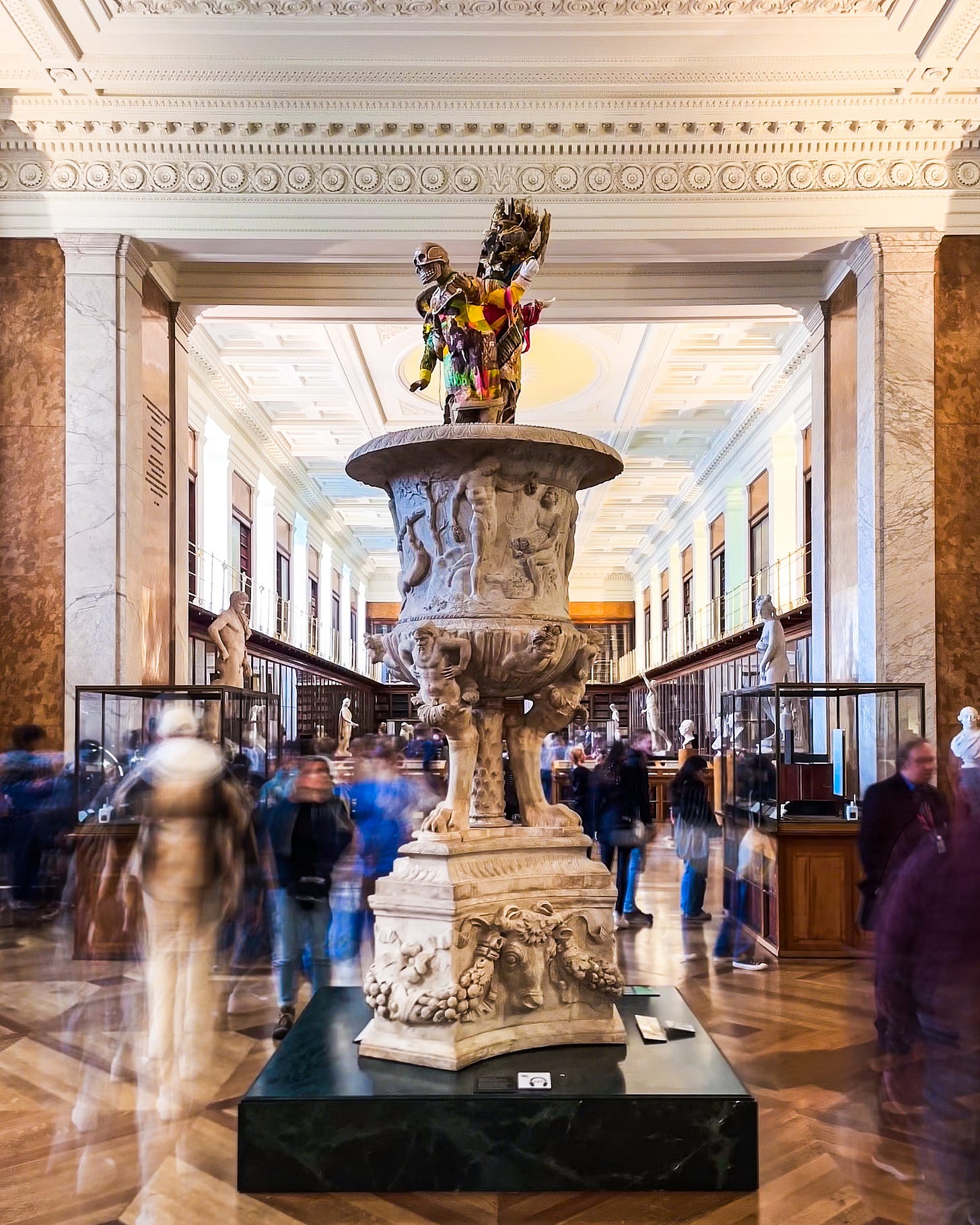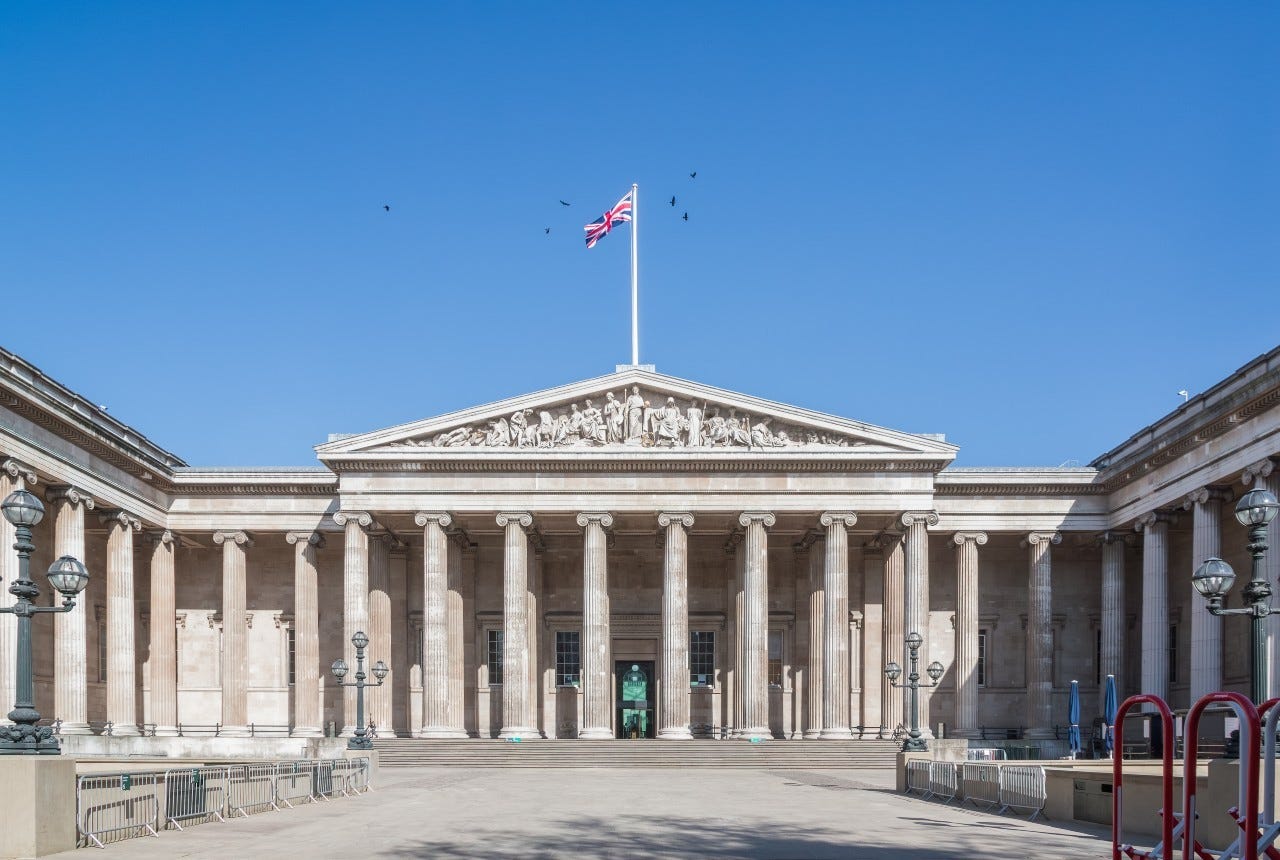Tuesday 04 February 2025 | views from the world of museums, galleries, heritage and art
Hello.
Remember that sensational long-read on the British Museum published in the Guardian last month? I’m delighted to say that its author Charlotte Higgins is today’s Big Interview, giving you the inside scoop on what will surely be in contention for article of the year come December.
In the 250 Take, Gareth Gardner asks us all to support our independent galleries — including his eponymous London space — as the future for these venues is looking increasingly shaky.
And in the Hot List, there’s a fashion first at the Louvre in Paris and seminars on Egypt’s greatest rulers.
Let’s dive right in!
— maxwell
The Hot List
My curated round-up of what’s new to see, do, watch, read and more. From the UK and around the world.
*I may earn a small commission from purchases made through some links below
EXHIBITION
1️⃣ Brasil! Brasil! The Birth of Modernism | at the Royal Academy, London
Over 130 paintings by ten important Brazilian artists from the twentieth century capture the diversity of Brazilian art at the time. It “will warm any sun-starved soul” according to the Telegraph.
now open until 21 April | find out more
BOOK
2️⃣ Gilbert & George and the Communists | by James Birch with Michael Hodges
This remarkable first-hand account charts art dealer James Birch's seemingly implausible mission to introduce British art's most subversive duo to the creaking remnants of Soviet Russia, and then Maoist China. Spoiler: it worked.
published by CHEERIO | grab your copy here
EXHIBITION
3️⃣ Louvre Couture: Art and Fashion — Statement Pieces | at the Louvre Museum, Paris
The world's most-visited museum opens its first ever fashion exhibition. 100 items are shown across the nearly 100,000 square feet of its decorative arts department. There’s Chanel, Saint Laurent and Dior. Oh my.
now open until 21 July | learn more
RADIO
4️⃣ Moving Pictures | on BBC Radio 4 and BBC Sounds
A new series of the show that examines a work of art in-depth with experts — and counterintuitively, is on the radio. The series opener was Rembrandt’s A Woman Bathing in a Stream. Tonight’s is the V&A’s The War of Troy tapestry.
Tuesdays at 16:00 | or listen back here
SEMINAR
5️⃣ Ancient Egypt's A-List: Power, Empire, and Propaganda | online
History-lovers can spend their Saturday immersed in the world of Ancient Egypt’s most powerful rulers. This online four-session talk programme is presented by the Smithsonian Institution and dives deep into four leaders including Cleopatra.
Saturday 08 Feb at 10:00 ET / 15:00 GMT / 16:00 CET | book your place
The Big Interview
Three weeks ago, I opened an edition of this newsletter with my thoughts on an article that blew my socks off. It was the 5,000-word deep dive into the British Museum published in the Guardian and penned by its chief culture writer Charlotte Higgins.
I told you I had not read such a full-bodied inside-snapshot of a major museum before.
Well, it seems many of you agreed. Hundreds of you clicked to read the piece. My posts on social media saw massive spikes in engagement. And my DMs lit up with praise for the essay.
The only logical next step — as this is a newsletter with a mission to bring you the inside track on all things museums — was for me to get you the full lowdown on this sensational piece.
Which is why I’m thrilled that this week’s interview is with Charlotte herself.
Charlotte’s been writing about the British Museum for years, and her article was the culmination of all that knowledge and time spent in the orbit of Britain’s oldest public museum. But as I found out in our chat, an institution as vast as the BM still was able to throw up some surprises.
So read on to deep-dive into Charlotte’s deep-dive, and discover who she interviewed (and who she didn’t), how such a huge investigation evolves, and what the reaction has been — including on the inside.
***
Hello Charlotte! So first tell us, when did you start working on the article — and how did it come about?
At the end of 2023, Clare Longrigg, deputy editor of the Guardian’s long read, turned to me one day in the office and just said, “The British Museum”, and I said, “Yes!” and that was it.
It felt like the right moment to draw a lot of threads together. I’d previously pitched a piece specifically on the Parthenon sculptures — maybe two or three years ago — but my editors had felt that not quite enough was shifting to warrant it at the time. I started properly working on the piece at the start of 2024, but there again, I had been reporting on the museum for two decades, so had already built up a fund of knowledge to draw on.
Articles like this are a huge investment of time. It’s unique in British journalism to have a section like the Guardian’s long read sitting in the middle of the main section of a daily paper: a little internal operation that works more like a US magazine. The long read is about deep reporting, long conversations about structuring a piece, and an often painful editing process.
It’s not every writer’s cup of tea and I always find it demanding. But Clare and the editor of the long read, David Wolf, are the best in the business and their commitment to making every article the best version possible of itself is something I am totally signed up to.
How many people did you speak to for the piece?
Well, a lot of people. They fell into a couple of categories.
There were people on the inside — ‘signed off’, as it were, by the British Museum. I asked the press office if I could see various particular curators and departments at the museum. I knew little about the Science department, so that was important. I wanted to know about the museum’s role dealing with the bureaucracy round the Treasure legislation, which led to a long and fascinating conversation that got boiled down into half a sentence in the piece.

I wanted to go into Prints and Drawings. I wanted to go to the new storage facility in Reading. I wanted to talk to the Human Remains specialists. I wanted to see the Recovery Team — those trying to trace the gems that had disappeared from the Greece and Rome department. I spoke to the interim director of the museum, Mark Jones, and to the new director, Nicholas Cullinan. So that was the “official” category of interviewees.
Then there was a bunch of other people, most of whom did not want to be quoted on the record — mostly former and present staff members and trustees. For a long read like this, there is relatively little quoted material relative to the number of conversations — most people aren’t quoted at all. The encounters are more about building a deep picture of what I’m writing about, though it leads to an almost unmanageable mountain of notes and transcripts. I think of it as creating a kind of forest of knowledge. Then the trick is to machete a path through all that undergrowth to create a coherent story.
Hartwig Fischer, who resigned after the alleged thefts were revealed, politely declined to be interviewed, and I think he was my only straight “no”.
Many conversations took place off the record, though I usually add the proviso that if there is anything I’d specially like to put on the record I’ll check in with the interviewee at the time of writing.
So how do the 5,000 words evolve over these many months?
I have a feeling that I could have written a whole bunch of stories about the museum. We could have focused on the disappearance, or the recovery of, the gems. But there had been a lot of coverage of that already. We could have found a single character who could somehow have carried the story of the museum with them — we wondered even about, say, finding a museum attendant, or some other staff member to focus on.
The one thing we were sure of was wanting to express how the museum is at a watershed: emerging from acute crisis, a lot of questions hanging over it, a new director, a vast capital project in the offing. While doing the reporting, I would keep coming back to David Wolf, the editor, with new titbits of information, little stories from inside the museum, and we got more and more into the idea of the piece being about an institution you think you know, but don’t really. He had this image at one point about a building seen in section, as in a Wes Anderson film, with people doing strange and fascinating things inside it.
I love working with my brilliant colleague, photographer David Levene, and sometimes we would come out of the museum pinching ourselves that we’d seen such remarkable things.
One thing we almost always do with pieces in the long read section is insert time into them — by which I mean that they depend on multiple encounters and the feeling of time passing during the reporting. That happened in quite a brutal way with this one as my father became ill in April and died in August, which delayed the piece twice and stretched the reporting even longer than I would have liked. In the end it was very heavy work to pull it together, and it’s sad for me that he never got to read it.
🔗 IN PICTURES | See David Levene’s behind the scenes images at the British Museum here
You spoke to many key staff, and the Guardian was allowed to photograph behind-the-scenes. It sounds like the museum was very cooperative, is that fair?
A piece like this, where you want to see behind-the-scenes, depends on some level of internal co-operation, and there is generally a courtship period (my previous long reads on British institutions such as the BBC, the Palace of Westminster and the Booker prize, similarly).
Generally that’s me having a meeting with some kind of head of communications and explaining the project, emphasising it’s going to take up a lot of time, and that it will be a serious piece of work. I guess we were lucky that the museum had sort of decided that it needed to be more open. I imagine that having written about the museum for many years meant I was a known quantity to a certain extent.
Once they had agreed they were cooperative, and agreed to pretty much all of our access requests. I dislike doing interviews with a press officer in the room, however delightful that person is, but that’s something I had to live with — and of course one explores unofficial avenues for a slightly more unvarnished view.
I did a fair bit of checking factual stuff back with curators while I was writing. They were uniformly generous and forthcoming in explaining their work. I toyed with the idea of requesting an interview with George Osborne, the chair of the museum, but felt it wouldn’t add anything much.
As you say, you've been covering the British Museum for many years. But did anything surprise you about it when working on this — did you still discover new things?
Something I was incredibly keen to understand for myself was what does a collection of 8 million objects mean? What does that even look like? What is the range of objects in the collection and why is it so enormous? I hope I found a way to try to do that in the piece.
There were also lots of very cool individual stories that I'd no idea about: cuneiform tablets being flown to Iraq on the president’s plane after the king’s coronation, for example; or Egyptian mummies being sent to the Royal Brompton Hospital for an MRI on a Saturday morning.
I read a few books on the museum's history, which is completely invisible in the piece but was somehow helpful ballast for me, and interesting. Lurking in the background, again invisibly, was an amazing, violent, strange novella set in the museum, by a former museum guard — SJ Fowler's Mueum.
Sadly I already knew about low staff morale, appalling pay, and some employees having to use food banks.
What's the reaction been to the piece?
The warmth of the reception surprised me, partly because people have such strong opinions on the museum, and my personal balance of love/critique will not have aligned with every reader’s views. One thing that is satisfying about writing for the long read, though, is that readers do recognise and respond to the fact that you have evidently done a lot of work and taken a lot of care. I did get a few nice messages from people on the inside.
Were there any aspects you couldn't fit into the finished piece that you'd like to mention here?
I think I’ve said enough about the museum for now. I suppose what I ended up feeling — which I think is in the piece — is that the BM is an institution which has extraordinary, public-spirited people working there out of love and passion, but that is in a state of apparent stasis about the big questions that outsiders ask of it.

Are you hopeful for the British Museum's future?
I try to be an optimist.
Nicholas Cullinan has an uphill struggle and I hope he’s ready for it. The museum is an extraordinarily complex mechanism, and I think you would have to be remarkably attuned to detail to understand it — and of course also to be on top of the big picture around politics and perception of the museum and its overall direction. It is going to take more than a rebrand (currently out for tender I gather) to fix all this.
I do feel that something probably needs to shift on the restitution question: personally, I’d say agreeing some kind of set of principles and a process that could be applied to contested objects on a case by case basis. Such processes already exist for certain categories of things in the collection, such as human remains and items found to have been looted by the Nazis.
Finally, with your crystal ball, will we see the Parthenon Sculptures going to Greece?
At some point, probably!
— Read all of Charlotte’s work for the Guardian here.
The 250 Take
Today’s 250-word guest column is by Gareth Gardner, the founder and curator of the UK's only gallery dedicated to the photography of architecture. He wants us all to use independent galleries more, as he fears for their future.
💬 Britain’s gallery scene is on a downer — it’s use or lose time
“Picture it. Deptford, 2019. I launched my gallery/studio space, the UK’s only venue dedicated to photography of architecture and place. Optimism reigned, unicorns frolicked, rainbows arched across South East London.
Open the door and they will come.
Except they didn’t. No sooner had the door been replaced after a destructive break-in, than it was closed for much of the pandemic.
As restrictions lifted, the door swung back into regular use. Visitor numbers flourished, but ongoing economic hurdles — Covid, Brexit, Ukraine, Truss et al — have noticeably dented spending power.
At this point don’t Google the state of Britain’s gallery scene. It’s a major downer. Many venues have simply given up and closed their doors. Yet independent galleries are vital links in a nationwide chain of creative infrastructure and their loss is widely felt.
For me, it’s more than money. My gallery was established as a passion project, offering exhibition opportunities to emerging photographers, engaging with the local community and inspiring visitors to think about architectural photography. Our door is open to all, a welcoming space to learn, create and share.
Paramount is attracting visitors through the door, spreading the word and generating buzz. But some commercial success helps us to develop our exhibition programme and support our artists, a situation replicated at venues throughout the land.
So wherever you live, get off your bum and visit a gallery. Go through those sometimes intimidating doors, explore exhibitions, speak to curators, give feedback and buy some art. It’s use or lose time.”
The Gareth Gardner Gallery is open this Saturday for the final day of an exhibition of 12 photographic projects and their accompanying self-published photozines. Other visits are by appointment.
— Thanks for reading to the end. If you found today’s edition useful, please donate to support future editions.






